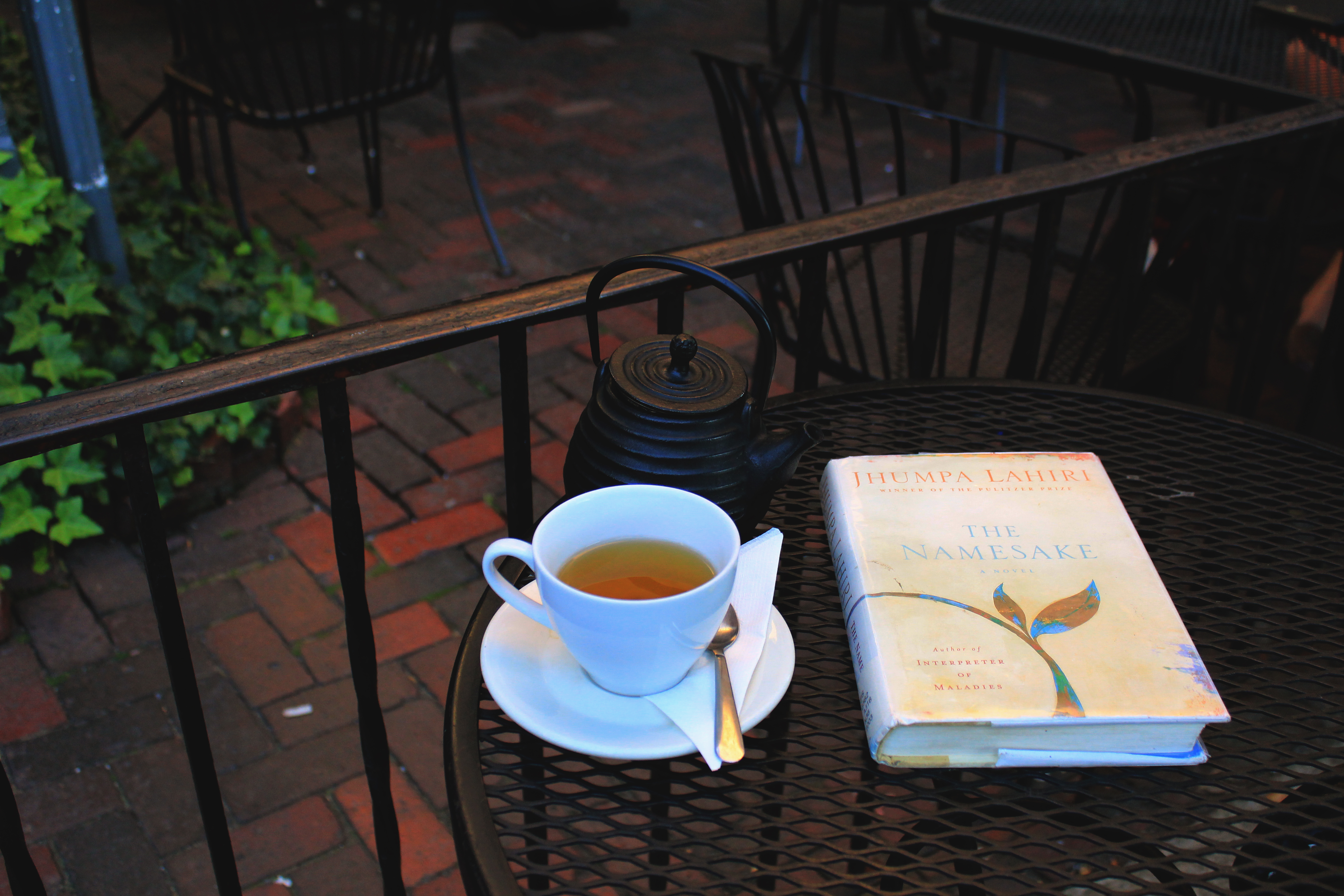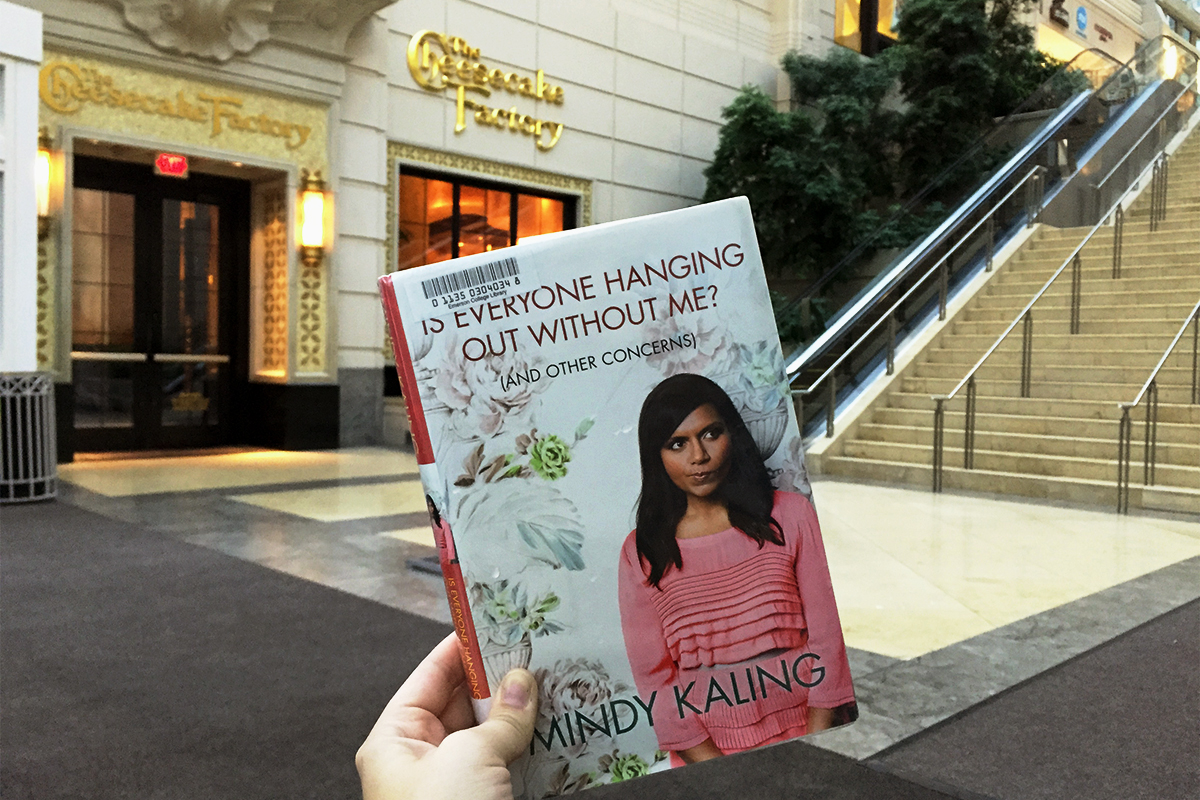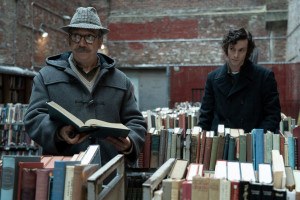Popular Books Set in Familiar Boston Locations
Later this month, literature lovers will flood the city for the 2015 Boston Book Festival, where authors ranging from Margaret Atwood to Amanda Palmer are slated to appear. To help get you primed for BBF 2015, we’ve rounded up nine popular works with scenes set right here in the Boston area.
Café Pamplona

Jhumpa Lahiri’s The Namesake atop one of Café Pamplona’s outdoor tables, next to a cup of tea. / Photo by Anna Buckley
Mentioned in both Jhumpa Lahiri’s The Namesake (2003) and Amanda Palmer’s The Art of Asking (2014), when it opened in 1959, Café Pamplona was the first of its kind in Harvard Square. In The Namesake, main protagonist Gogol and his at-the-time secret girlfriend Ruth spend the day in Harvard Square, catching a movie at the Brattle Theatre and then eating pressed ham sandwiches and bowls of garlic soup in a corner of the café.

Amanda Palmer’s The Art of Asking beside a menu, displaying Amanda Palmer’s own self-titled drink. / Photo by Anna Buckley
With its original checkerboard tile, bright yellow walls, and an extensive tea list, Pamplona is the kind of café where you can sip espresso while eavesdropping on fellow customers’ arguments over Descartes’ philosophies—or catch an author hard at work. Palmer is a regular, having completed a large portion of her book at the café, and her favorite drink is named after her on the menu: The Amanda (no, not Arnold) Palmer. In the acknowledgments of The Art of Asking, Palmer writes, “As for Boston, there is only beloved Café Pamplona,” and notes that, akin to fictional Gogol and Ruth, she would recommend the garlic soup.
Boston Public Library

David Foster Wallace’s Infinite Jest rests on a windowsill in the BPL. / Photo by Anna Buckley
There are countless Boston references buried between the pages of David Foster Wallace’s Infinite Jest (1996), and there’s even a website dedicated to highlighting these spots called “Infinite Boston.” In the novel, Enfield is generally representative of real-life Brighton, and alludes to the old town of the same name that is now submerged under the Quabbin Reservoir. One specific location mentioned is that of the grief and trauma stacks at the Boston Public Library. “I went down and chewed through the Copley Square library’s grief section. Not disk. The actual books,” says Hal, the novel’s protagonist.
The Escalator Next to the Cheesecake Factory

Mindy Kaling’s Is Everyone Hanging Out Without Me? in the Pru, across from the Cheesecake Factory. / Photo by Anna Buckley
Though it’s impractical to read a book on an escalator, Mindy Kaling’s memoir/observational essay collection Is Everyone Hanging Out Without Me? (2012) mentions a very specific moment you pretend to relive, briefly. Mid-memoir, Kaling recalls the day JLMP (Jana, Lauren, Mindy, Polly)—her high school girl gang—became JLP. Riding down the escalator at the mall (which area mall isn’t actually specified) located next to the Cheesecake Factory, she looked into the restaurant’s windows to see JLP on their weekly girl clique date, without her.
The Charles River Running Paths

Junot Diaz’s This Is How You Lose Her atop a park bench beside the Charles River running paths. / Photo by Anna Buckley
In Junot Diaz’s The Cheater’s Guide to Love (2012), originally printed in the July 2012 issue of the New Yorker and then published in his collection, This Is How You Lose Her, the running paths next to the Charles River, on the Cambridge side, play a key role in the narrator’s slowly developing triumph over heartbreak. “You used to run in the old days and you figure you need something to get you out of your head,” he writes. “You must have needed it bad, because once you get into the swing of it you start running four, five, six times a week. It’s your new addiction.” These paths offer a stunning view of the Boston skyline—a kind of brick red serenity by day and twinkling marvel by night. One walk or run along the Charles and it becomes evident why the narrator of this Diaz story was drawn to the locale.

Haruki Murakami’s memoir, What I Talk About When I Talk About Running beside the Charles River. / Photo by Anna Buckley
Like Diaz’s story, Haruki Murakami’s memoir mentions running along the Charles. Not only does What I Talk About When I Talk About Running (2007) give you sage life advice like, “Pain is inevitable. Suffering is optional,” and, “The only opponent you have to beat is yourself, the way you used to be,” but he also has some intriguing thoughts on running as a form of therapy. The author details the way the energy of the river pulls people to its banks, the beauty of the body of water as it changes with the seasons, and the types of people he encounters on the trails. “Next to the boathouse by the river was a homeless man wearing layers of filthy clothes,” Murakami writes. “He was pushing a shopping cart and belting out ‘America the Beautiful.’ Whether he really meant it or was being deeply ironic, I couldn’t tell.”
Boston Common

Stephen King’s Cell on a rainy morning in the Boston Common. / Photo by Anna Buckley
If you were standing in the Boston Common and saw a man go ballistic on his own dog, trying to bite the canine’s ear off, what would you do? You’ll find said scene in Stephen King’s Cell (2006), in which main character Clayton Riddell is separated from his family in Boston as the Pulse destroys humanity. Hopefully, your personal visit to the Common won’t result in a cellularly transmitted broadcast that turns people into violent beasts…but hey, you never know.
The North End

John Irving’s Last Night in Twisted River against a brick wall in the North End, behind the historic North Church. / Photo by Anna Buckley
In John Irving’s Last Night in Twisted River (2009), Dominic and his son Daniel spend their lives on the run after Daniel commits an accidental murder in which he mistook his father’s girlfriend for a bear. One of their places of refuge is the North End, where Dominic gets a job and changes his surname.
Harvard Area

Margaret Atwood’s The Handmaid’s Tale next to one of Harvard’s numerous brick buildings. / Photo by Anna Buckley
Margaret Atwood’s The Handmaid’s Tale (1985) is a grim one, as it’s set in a future version of Cambridge during which the United States has been taken over by the totalitarian regime of Gilead. The story feels even more bleak when one stands in Harvard Square with a copy of the novel and reads about a wall outside of an abandoned Harvard University, where the bodies of the rebel forces hang. To imagine Cambridge the way it is in this book is to imagine atrocity itself.


